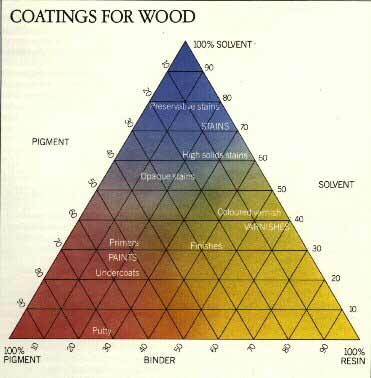Surface coatings for wood

A useful starting point from which to describe surface coatings is with a 'generic' or 'family' name. Coatings for wood are conveniently described by three archetypal terms, paint, varnish or stain as follows.
- Paint. A pigmented material which, applied in liquid form to a surface, forms, after a time, a dry adherent film.
- Varnish. A transparent coating.
- Stains. These can be low to medium build coatings which are either semi-transparent, i.e. they are coloured but allow the underlying surface to be seen or they can be opaque, obliterating the surface.
These definitions do not take the chemistry of pigment or binder into account nor do they indicate whether the carrying medium is aqueous or non-aqueous.
If the composition of coatings is simplified to the essential basis of thinner, binder and pigment then these definitions reflect the relative proportions of the main ingredients and can be illustrated in simple compositional terms as in the illustration, right. Certain broad characteristics would be expected:
- Paint. High-build pigmented films obliterate all of the coarser features of wood and offer good resistance to both sunlight and moisture. But water penetrating behind the paint may be unable to escape and can cause flaking and cracking if the paint system lacks permeability.
- Varnish. The higher solids content of varnish and the lack of pigment yields an attractive high-build film which enhances wood's beauty Thick films are more likely to flake, particularly if the coating or substrate are exposed to the sun. Redecoration of transparent coatings to a high standard can be very difficult if the substrate has become disfigured.
- Stain. Yields a thin penetrating film which is more likely to fail by erosion than flaking. This leads to easy maintenance. The very thin film also means, however, that protection, in the sense of controlling moisture movement, will be poor unless it is renewed frequently.
These product types offer the user a choice of appearance and, while individual products vary, each has certain. inherent advantages and disadvantages.
For many years formulating chemists have worked to overcome the disadvantages while building on the strengths. This has been achieved in three ways:
- Changes to the proportions of the main ingredients - this creates product types of an intermediate character.
- Changes to the system as a whole - for example by moving away from a separate primer, undercoat and finish to a combined or self-priming paint.
- Compositional changes - including new pigments, binders and changes in the carrying medium.
These formulating options have created new products, often blurring the boundaries between the three basic stereotypes.
This has contributed to the confusion in the nomenclature. But it is still possible to relate the newer products to the underlying framework and users should insist that new products are defined by established terminology.
